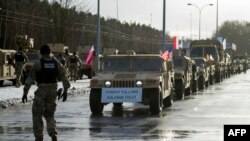Russia has exaggerated the significance of the arrival of 4,000 troops from the U.S. Army's 3rd Armored Brigade Combat Team, 4th Infantry Division in Europe, along with approximately 2,500 pieces of military armor, part of Operation Atlantic Resolve.
While this may be the largest deployment of U.S. forces to fellow NATO members since the end of the Cold War, it comes amid a gradual drop in the number of U.S. troops in Europe, where they have been deployed for decades since the end of World War II.
Furthermore, this fresh U.S. deployment comes at the request of the Baltic states and Poland, which, bordering Russia, feel especially threatened by a resurgent Moscow following its annexation of Crimea in March 2014 and its support, both financially and militarily, for separatists in eastern Ukraine.
And though the Kremlin strenuously denies it, Russian troops and military hardware have been sited on the battlefield in Ukraine’s Donbas region.
Dr. Igor Sutyagin of the Royal United Services Institute has estimated 90,000 Russian troops were deployed in and near Ukraine in 2014 to hold territory.
Ukrainian President Petro Poroshenko said in 2015 that 9,000 troops and 500 tanks and heavy artillery were still in eastern Ukraine.
In August 2016, the Pentagon reported 40,000 Russian troops amassed along the Ukrainian border.
Moreover, it is important to stress Russia's military superiority. When the Kremlin focuses selectively on U.S. troops, it fails to mention that the defense preparedness of some European states is suspect at best amid stagnant or declining defense budgets across the continent since the collapse of the USSR in 1991.
The British press commented this week that with little more than 5,000-10,000 of its own combat-ready troops, the UK could be taken over by Russia in an afternoon.
Last year, the Daily Telegraph reported that Russia could overrun the three Baltic states in three days because of its superior numbers of tanks and troops.
While Poland has the largest number of tanks in Europe (901 as of 2013) -- twice the size of the British army -- about half of them are antiquated Soviet-era T-72 tanks. By contrast France has around 400 total tanks and plans to reduce its armor force to half that size.
The correlation of Russian and NATO forces in Europe is a subject of a bit of debate, with some analysts pointing out that while Russia has far greater numbers of troops -- estimated between 771,000 and 810,000 -- they are deployed across the vast territory of Russia, in some cases very far from the Baltic states.
Yet large-scale military exercises in the last two years have underscored the fact that Russian troops are combat- ready and able to move quickly, as they have done at key periods in the conflict in eastern Ukraine. Plus, Russia has two million reserve personnel, some of whom have fought in the Donbas or Syria.
While in theory the combined armed forces of all EU members (1.4 million) is numerically greater than Russia's, they are not all in a position to act in unison rapidly against potential Russian aggression.
Some NATO countries have been reluctant to draw attention to the numbers of their troops and tanks for fear of projecting weakness. But media estimates of NATO's rapid reaction force usually indicate 40,000 troops total available to send anywhere in the world. A 5,000 strong spearhead force could deploy within 48 hours.
Add to this number the fresh U.S. troops and armor, and it is a significant deterrent, but hardly the disruption of any "balance" or "security architecture" as implied by Russia.
Russian media regularly downplay the capacity of the Russian army by only describing the 30,000 troops directly near the border of Eastern Europe and contrasting them to the combined number of Baltic and Polish forces. (Reliable estimates put the number of troops for all four at 115,000 with 77,000 of these Polish) Not surprisingly, Russian estimates for the size of Baltic and Polish forces are frequently inflated.
Russia is countering NATO's deployment with its own increases. In May 2016, Russian Defense Minister Sergei Shoigu said the Russian army would create three new divisions to counter NATO's four battalions (4,000 troops); two of these would have 10,000 troops each, one in the Southern Military District and one in the Western Military District.
Indeed, this is why in the past, NATO has deployed cruise missiles as a deterrent to Russia's greater superiority in conventional forces which continues today.




